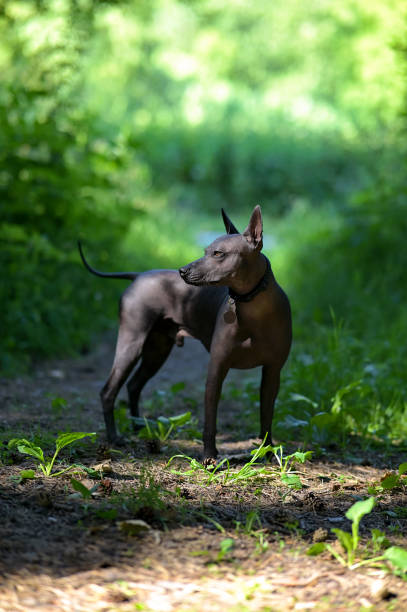Many myths revolve around South American hairless dogs: They are said to have changed little for thousands of years and were worshiped by Native Americans. The beautiful hairless was even said to have magical powers! Today, the Mexican Hairless Dog is one of the best-known exotic breeds, although they are almost never seen in this country. We clarify why this is and why hairless dogs are not always naked.
External Characteristics of the Xoloitzcuintle – A Dog Like 3000 Years Ago
Externally, small South American dogs have hardly changed for thousands of years. They are bred in all sizes: from mini dogs with a height of about 25 cm at the withers to large guard dogs with a height of 60 cm, all sizes are included. The noble four-legged friends with the original appearance were not named after the dark Aztec god Xolotl without reason.
Sizes of Mexican Hairless Dogs
- Standard size: 46 to 60 cm at the withers, they rarely weigh more than 25 kg. American breed standards state up to 67 cm.
- Medium size: 26 to 45 cm at the withers
- Miniature Xolo: Height at the withers between 25 and 35 cm
Breed standard

- The head shape in the standard variety differs slightly from the smaller varieties. Only the standard variety with a broad, wedge-shaped skull is described in the breed standard. Hairy Miniature Xolos are more like Chihuahuas with a deer head. The stop is well defined but not too angular.
- The muzzle is about as long as the skull, straight and very strong. Most hairless dogs have an incomplete set of teeth. The nose can be black, brown, pink, or spotted.
- Some Xolos have their tongues hanging lamely out of their mouths, which is a serious breeding fault according to the breed standard. The pink tongue may be darkly mottled.
- The medium-sized almond eyes have a very intelligent expression and should match the color of the skin and coat. All colors from dark brown (almost black) through brown and amber to light yellow are allowed. Blue eyes are not found despite the distant relationship to Siberian arctic dogs.
- The very flexible bat ears are long and have a rather fine structure. When excited, they are carried upright, when relaxed they stand at an angle of 50 to 80 degrees from the body. Up until a few years ago, hairy Xolos were also allowed to have crooked and rose ears, but today the description is the same for both types.
- The elegant and slender neck is a typical feature of the breed. In puppies, the skin of the neck folds slightly, which disappears in adulthood.
- The body is slightly elongated and very strongly built, the abdominal line is only slightly tucked up and ends in long, strong loins.
- Flat and well-muscled shoulders give the dogs a lot of freedom of movement. The hind legs are also well muscled and only slightly angled. Protruding hip bones (“cow humps”) are highly undesirable.
- The thin and slightly curved tail of the naked perro pelón can have light downy hairs that get shorter from the tip to the base. Hairy dogs do not form a brush, they are evenly haired with short hair.
Unique coloring for each dog
The variety of colors and distribution of fine hairs on naked Xolos gives most members of the breed and individuals, an unmistakable look. All colors are allowed, with solid and dark colors being preferred for inbreeding.
Hairless (perro pelon)
- No hair grows on the entire body, but soft down is accepted in places.
- A visible medium-length mop of sparse hair grows on top of the head in some dogs.
- Sometimes a little hair grows on the tail too.
- There are different skin types, from rather thick and firm skin to very thin, elastic skin. The skin type is not necessarily related to the size of the dogs.
Coated (hairy)
- Short, even and straight hair grows all over the body.
- Even the hairy Xolos have no undercoat.
- The coat pattern is very easy to see on the hairy type.
These colors are common
- Black
- Seal (brown)
- Charcoal (bluish-gray)
- Gray (ash gray light to dark)
- All shades of brown (dark, reddish to blonde)
- liver-colored
- brindle
- Shades of cream (champagne to yellowish-white) are rarer than dark colors and mixed colors
- Black and tan with red tan badges
- Tricolor
- White markings of any size are allowed (often with dark spots or piebald)
- All colors can be monochromatic or mixed (light or dark clouds or piebald with plates).
The Incredible History of the Native American Dogs from Mexico

Like Chihuahuas, Xolos are descended from the dogs of the first Native Americans who migrated to America from Siberia across the Bering Strait. When the FOXI3 mutation first appeared remains a matter of debate, but it is estimated that the hairless dogs could have existed for around 3000 years. Hardly anything remains of the pre-Columbian genes after European colonization of the Americas, but the outward appearance has changed little over the centuries.